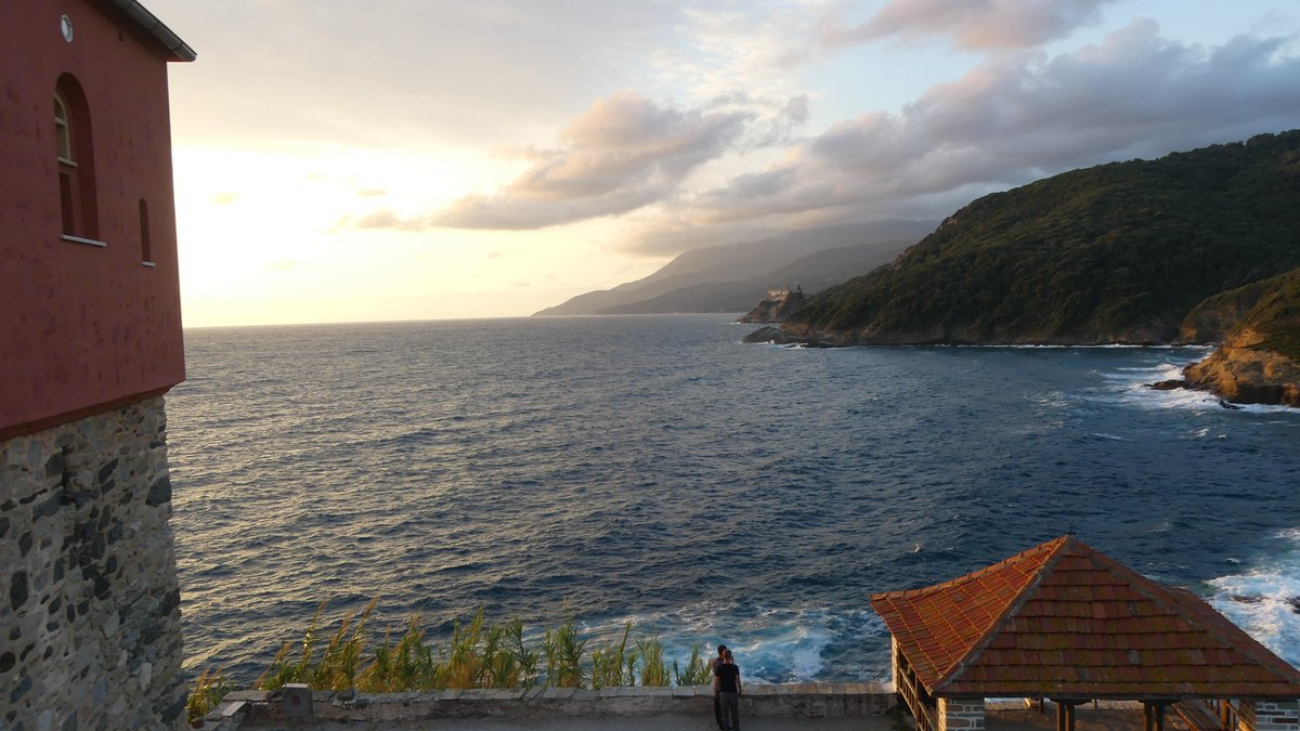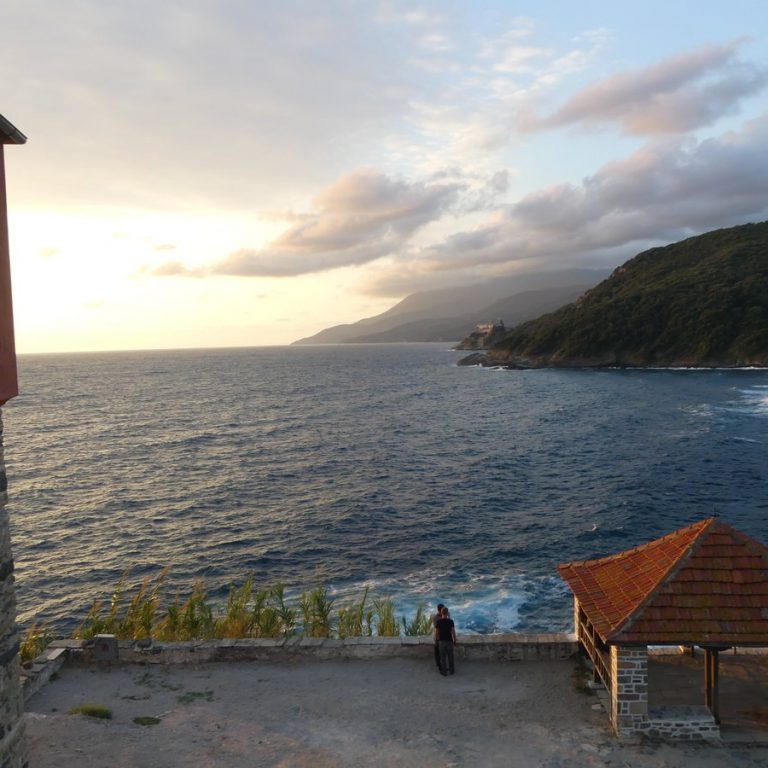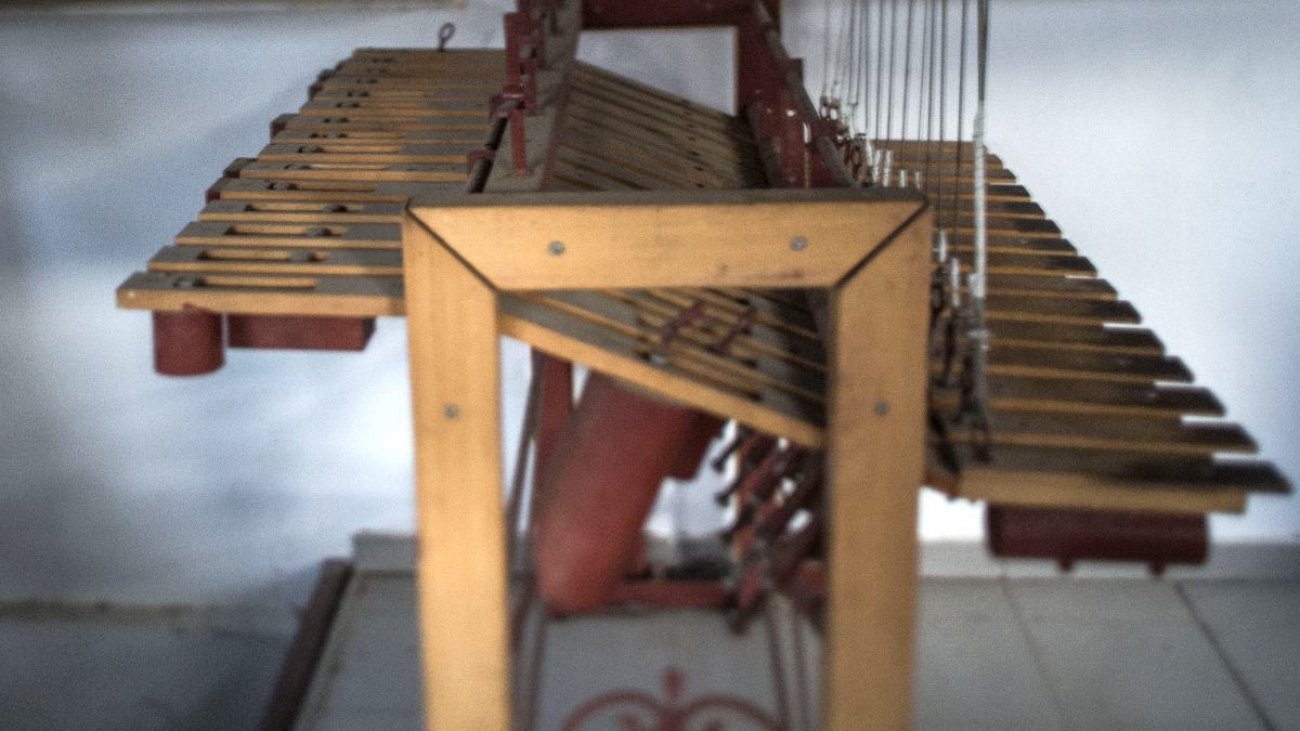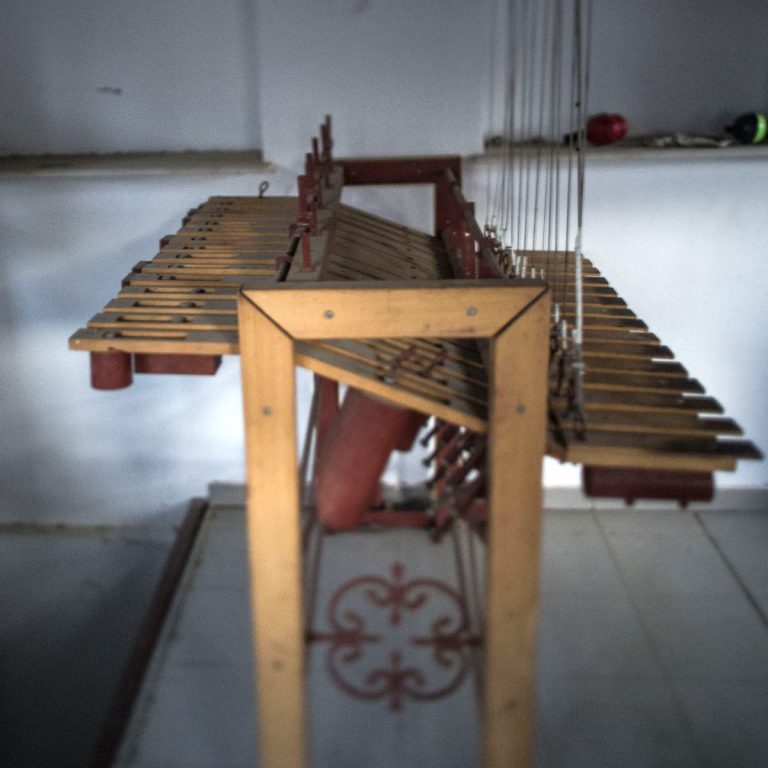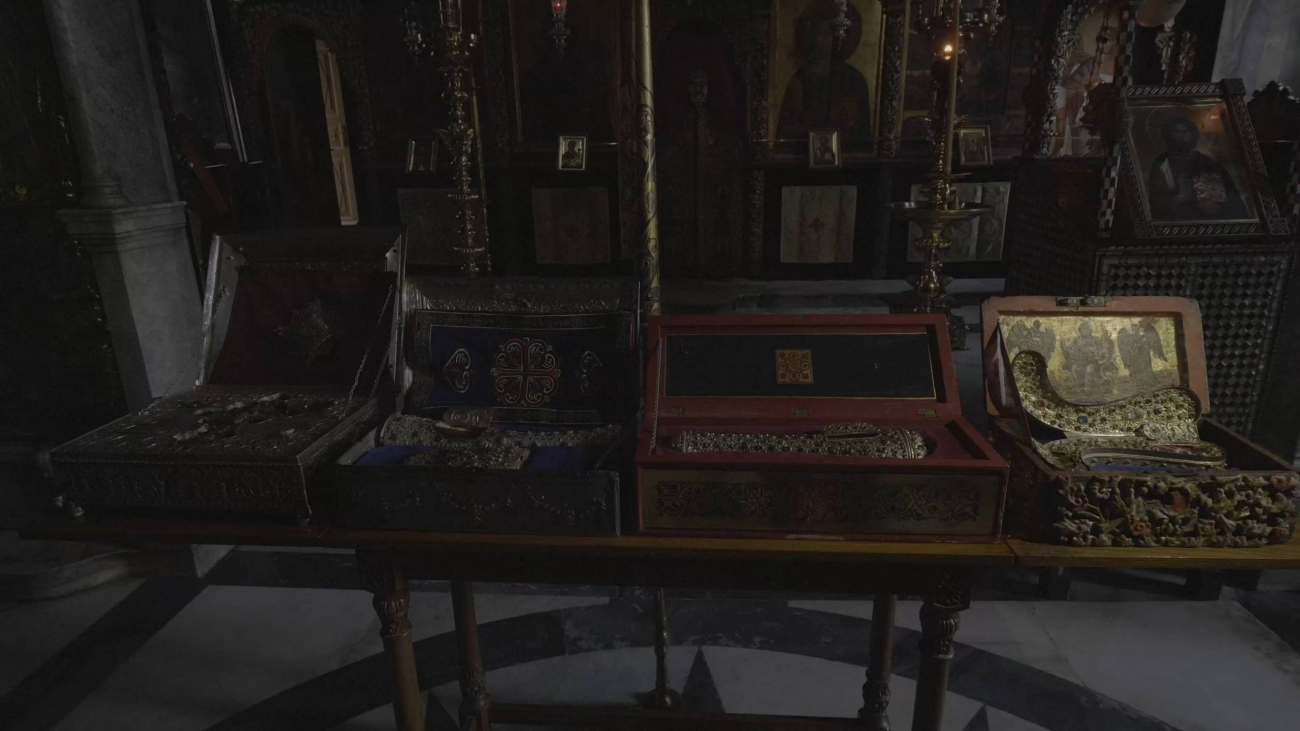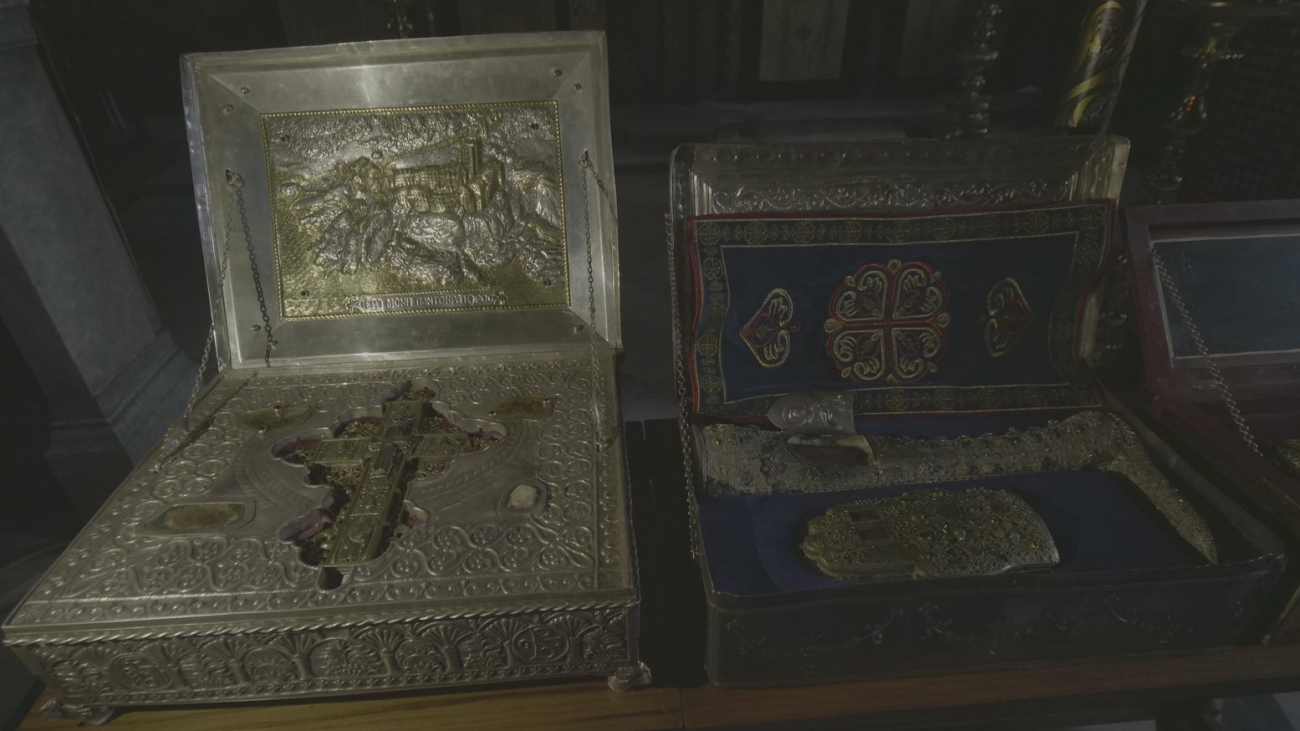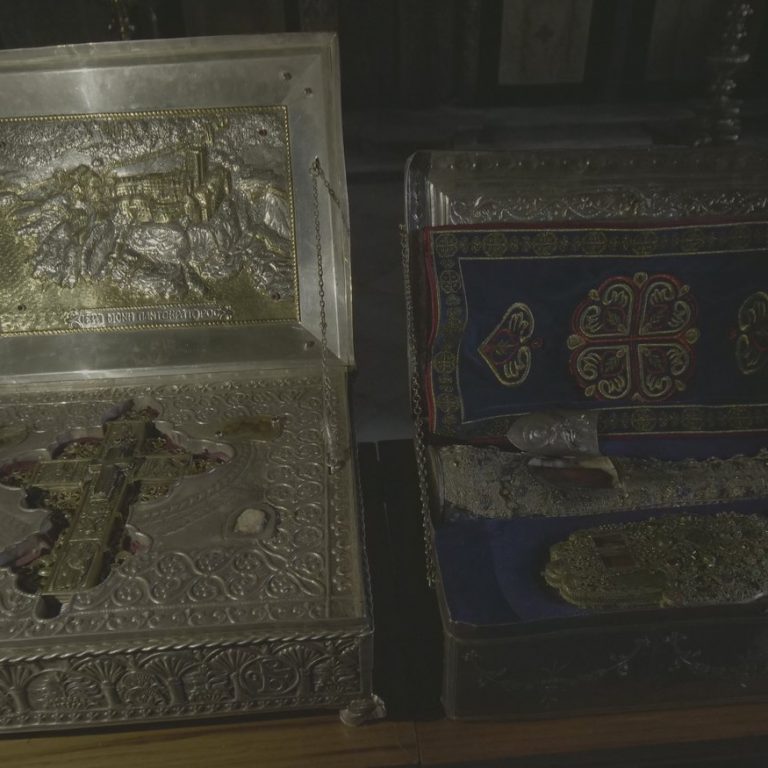Apart from its dependencies (both properties and Athonite Cells), a number of saints are connected to the centuries-long history of the Monastery, some of whom played significant roles in the spirituality and the development of Athonite monasticism.
1) St Gregorios of Palamas (1297-1359). The father of Byzantine Seclusion (i.e, cloistered way of life) St Gregorios of Palamas, lived for a long period of time at Agios Oros, from time prior to 1325 and after 1331, and also after he had been elected as Bishop of Thessaloniki in 1347. According to the tradition at the Pantokratoros, he also lived for some time in the region belonging to the Monastery. In any case, the founding of the Monastery coincides with the period of his tenure as head of the church in Thessaloniki. St Gregorios is depicted as a monk in a fresco in the refectory of the Monastery, and his memory is celebrated on 14 October and the second Sunday of Lent.
2) St Kallistos I, Patriarch of Konstantinople (end of the 13th century-1363/4). The Patriarch Kallistos I, student and biographer of St Gregorios of Sinai, served for decades on Agios Oros (at the Magoula Skete, the Iviron Monastery, and other places). He was a dominant figure in Athonite monastic society. According to a solidly based Athonite tradition, he served as the Sea of St Onoufrios, a short distance north of the Monastery.
The name of St Kallistos is connected with, as is known, the founding of the early years of the history of the Monastery. According to surviving testimonies, Kallistos inaugurated the cathedral of the Monastery, and provided the monks with the first set of guidelines (typiko) for its efficient functioning, which by that time had become the Ecumenical Patriarchal Seat. The memory of St Kallistos is honored on 22 November and on 20 June.
3) St Nifon II, Patriarch of Konstantinople (1418-1508). St Nifon, who was from Thessaloniki, resided at several Athonite monasteries, and is considered the new founder of the Dionysiou Monastery. According to his biography, during his first arrival at Agion Oros and prior to his residence at the Dionysiou Monastery, St Nifon visited the Koutloumousiou Monastery, and then the Pantokratoros «ποιήσας χρόνον». He then took up residence in the cave Crete, which is located near Karyes, in the area which belongs to the Monastery. The area is said to be 'inhabited by great men [burdened with] major worries and extreme difficulties, whom the blessed Nifon admired for their extreme endurance. He lived among these teachers as a student, making a living from his calligraphy.' The memory of St Nifon is celebrated on 11 August.
4) St Theonas I, Metropolite of Thessaloniki (16th century). St Theonas ο από ηγουμένων, served at the Monastery at the beginning of the 16 century, as recorded in his biography but also from the evidence of the venerable martyr Iakobos. He was ordained as a priest and served as chaplain of the cathedral, until the period when he met Iakobos and became a member of his group. According to the tradition of the Monastery, he practiced at the Seat of St Onofrios, which has since been renamed as the Seat of St. Theonas. His memory is celebrated on 4 April.
5) St Theofilos the Myroblytis (1460-1548). St Theofilos, who was born in Zichni of Macedonia, lived during the first century after the Fall of Konstantinople, and is considered one of the most significant codice copier in Agios Oros during the 16th century, a period when the Athonite monasticism exceptionally fluorished.
After having served for a time as a deacon to the subjugated Greeks and also as a representative of the Patriarch of Konstantinople, he left for Agios Oros, where he first resided at the Vatopedios Monastery in 1510, and then at the Iviron Monastery. Finally, he withdrew to the Pantokratorian Kalyvi of St Vasileios in Kapsala, west of Karyes. There, St Theofilos resided together with the followers of Isaak, a community which he had previously renovated with the help of the Proton of Agios Oros, the venerable Serafeim. A short time prior to his death on Sunday, 8 July 1548, he wrote a will and a declaration of faith.
Unfortunately, the year of his death was erroneously recorded in his biography as 1558.
Despite his order to his subordinates not to publicize his death but to simply dispose of his body in the forest, the Pantokratorian monks found his remains, which were originally brought to the Monastery and later buried within the chapel of the Kalyvi of St Vasileios, accompanied by a large escort of monks. After their burial, his remains began to emit an aroma of myrrh, as 'one proof and definitive sign of [their] extreme cleanliness, virginity, and pureness, not only from physical contaminants, but also from contaminants of the mind,' as is noted by St Nikodimos, a situation which caused him to be referred to as Myrovlytis. His memory is celebrated on 8 July.
His right hand is preserved in a special reliquary at the Monastery, and in a fresco at the western wall of the entrance hall of the Cathedral, he is referred to as the Pantokratorinos.
6) St Gerasimos the Younger, from Kefallinia (1509-1579). St Gerasimos, a younger contemporary of St Theofilos, arrived at Agios Oros during the first half of the 16th century, perhaps together with the scholar monk Pachomios Rousanos, where he was tonsured as a monk and practiced for some years, until he left for Palestine. According to local tradition, he lived in the hermetic community of Kapsalas. His memory is celebrated on 20 October.
7) St Iosef, the Mitropolite of Timisoaras (1568-1656). St Iosef, whose mother was Greek, was born in 1568. Twenty years later, he came to the Monastery from Achrida, accompanied by another apprentice, Nikodimos. He was tonsured as a monk, his name was changed from Iakovos to Iosif, and he was later ordained as a priest. He worked as a copier of codices, and eventually left for other Athonite monasteries (Great Lavra, Chilandarios, Zeropotamos, Vatopedios, and Koutloumousios). In 1650, he was appointed as Metropolite of Timisoaras, where he lived until his death in 1656. He was canonized as a saint, having been responsible for a large number of miracles. His memory is celebrated on 15 September.
8) St Akakios of Kausokalyvios (1630-1730). St Akakios the Younger, the founder of the holy skete of Kausokalyvios, practiced for a short time prior to his final induction into the region of Kausokalyvios, at the 'skete of Pantokratoros, where this elder from Zagora lived harmoniously,' as is noted in his biography by Father Ionas of the same skete. By the phrase 'skete of Pantokratoros' is meant the Pantokratorian Skete of Kapsalas. The memory of the saint is celebrated on 12 April.
9) St Nikodimos the Athonite (1759-1809). This great father of the Religious Renaissance, together with the Elder Arsenios Moraitis, was inducted in 1777 'into the Cathedral of the Skete of Pantokratoros', while a short time later, in 1778, 'he bought the Kalyvi where the Cathedral blossomed, on the ridge which is called Theona.' Later, in 1784, he lived a cenobitic life with the Elder Sylvester of Kaisarea in the Kalyvi of St Vasileios in Kapsala, where as a high-ranking monk, co-authored the work Χρηστοήθεια ('The ethics of Christ') and synthesized the Ακολουθία (a collection of writings) of St. Theofilos. After that, he joined the 'Monastery of Pantokratoros,' where he lived as a monk for one year, after which he returned to Kapsala, where he 'bought the Kalyvi which is opposite to that of St Vasileios' (today the Kalyvi of St Nikolaos of Nikodimos).
St Nikodimos lived as an ascetic for a long period of time (about 32 years) in Kapsala (at the Kalyves St Mandiliou, St Nikolaos, and New Nikodimos), which is referred to repeatedly in his biography as the 'Skete of Pantokratoros', and was the ideal place for his life of monastic asceticism. Moreover, both during the period when he wrote Πηδαλίου ('The rudder',1800) and when he was writing his monumental Register of the Saints several years later, he worked in the library of the Pantokratoros Monastery, using the parchment versions of the Register in the library as his main source of information (as he states in the Prologue). His memory is celebrated on 14 July.
10) St Makarios Notaras, Mitropolite of Korinthos (1731-1805). The supporter and mentor of St Nikodimos while he was completing his important literary task, St Makarios Notaras, had gone to Agios Oros in 1777, remained for some time in Kapsala, and collaborated with St Nikodimos regarding the preparation of the publication of Filokalias (Love of the Beautiful), Euergetinos (a collection of spiritual writings), and other books. According to unconfirmed information, ownership of the Kalyvi where St Nikodimos lived had been acquired by the Monastery through a gift of bonds from St Makarios, which are preserved today in the Monastery. His feast is celebrated on 17 April.
11) St Paisios Belitskofsky (1722-1794). As an advocate for the Κολλυβάδων (Kollybadon; a movement within the church concerned with the restoration of traditional practices), St Paisios brought to the Slavic people the spirit of Filokalias and the Athonite ascetic experience. During the period of his residency at Agios Oros and his collaboration with the saints Makarios Notaras and Nikodimos, he chose as the site of his monastic practice the Cell of the Prophet Elias, which because of its many students, soon developed into the well-known Skete, which is a dependency of the Monastery. He also practiced at the cave Crete, where St Nifon also practiced. His memory is honored on 15 November.

